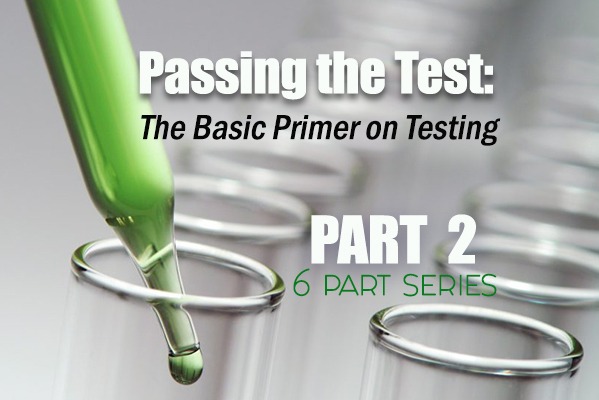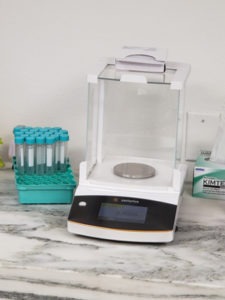BY MIKEL WEISSER
61 Tons, one gram at a time
When you or I “sample” or “test” cannabis, it usually involves twisting one up and burning it down. That process is called “organoleptic testing,” meaning tested based on tasting. (And that’s just one testing-related word you didn’t know you didn’t know.)
Aside from the weed, the whole enterprise costs little more than the price of a rolling paper. As much fun as that method might be, it’s small wonder cannabis testing labs have developed slightly more technical approaches to test medical marijuana.
In 2018, AZ dispensaries sold 61 TONS of cannabis, or 54,656,000 grams. Though many cultivators do test their potency and terpene profiles, no one knows many were tested for health and safety. But, thanks to SB1494, ALL cannabis sold in the Arizona medical marijuana system will be.
The scope of these changes is still sinking in for most of us. If you are one of the millions of Arizonans who can’t tell a “quad” from “’quot,” you’ve come to the right place. Here are some of the zillion things you never knew you didn’t know, about cannabis testing in AZ.

The Facts on SB1494
Passed at ten minutes till midnight on the last day of the legislative session, SB1494 changes the entire landscape for Arizona’s medical marijuana program. All in all, the official final Factsheet on 1494, contains 47 major provisions and featured 35 last minute amendments. Among the highlights:
- Starting November 1, 2020, ALL medical marijuana products sold to AMMA patients must be tested for health and safety. Contamination from mold, mildew, heavy metals, pesticides and residual solvents will all be regulated in keeping with common state MJ testing standards.
- A testing program is added to AMMA to license and regulate the independent testing labs who will conduct the quality assurance testing.
- Cannabis that cannot pass the health and safety standards will not be sold to the public as whole flower. However, remediation options are included, and the active ingredients could be isolated and extracted from the cannabis, avoiding the contaminants.
- Labs will not only have to register and be regulated by the state; they will also have to meet national and international lab standards to maintain their accreditation.
- A dozen member advisory board will be created to help write the provisions that shape the program.
- DHS will now be authorized to police the industry and penalize bad actors. Though the language details scads of levels of offense and consequence (warnings, notices, fines and so on), for the first time DHS will now have the ability to revoke the license of insistently bad actors.
- For the first time, DHS officials will be able to conduct anonymous health research on patient buying patterns to improve scientific research into cannabis effectiveness.
- Perhaps most importantly the bill contains a legislative intent clause, meaning that if Arizona should legalize adult use cannabis, these same medical marijuana health and safety standards will be required in the new adult use program.
- Probably the biggest news besides the health and safety provisions, SB1494 also extends all DHS cards, both patient and DA cards, to two years starting Aug 27, 2019.
- AND, thanks to the SB1286 language folded into SB1494 on the final day, the law now requires that some future dispensary licenses will be designated to rural areas. Further, these future dispensary licenses will have to stay in the rural parts of the state, Currently, rural licenses can move after 3yrs.
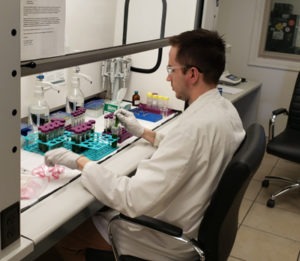
Types of Popular Tests
- Potency: While most people are looking specifically for a THC percentage, most testing labs identify percentages of at least half a dozen cannabinoids such as CBN, THCA and CBG. Tested with an HPLC machine. As Delta Verde Lab’s info page explains, HPLC machines are the preferred potency testing method because “gas chromatography cannot distinguish between these cannabinoids.”
- Terpene Profile: Besides creating the distinct flavors in various cannabis strains, terpenes often have medicinal affects also. With dozens of terpenes present in many strains, most labs test for the most frequently occurring. Tested with a GCMS machine.
- Residual solvents: Concentrates are made by dissolving the active ingredients in flower and separating them from the inert plant material in a solvent, then rendering away, or purging, the solvent in a low temp vacuum oven. Popular organic hydrocarbon solvents like butane, propane, hexane, ethyl alcohol and CO2 can get trapped in the extracted materials, affecting the flavor and causing their own health concerns.
- Heavy Metal Contamination—Just because they’re measured by the parts per trillion and few cases serious heavy metal toxicity due to cannabis consumption have been reported, heavy metals testing is serious business. According to US Federal Drug Administration (FDA) , harmful metals like Arsenic, Cadmium, Mercury, and Lead are all Class 1 contaminant: highly toxic with no known positive use for the human body, they accumulate over time. Occasionally present in metal shavings accidentally left over in vape cartridges, due to cannabis’ superior absorption properties, or phytoremediation, planting in contaminated soil will lead to contaminated plants.

As bad as pesticides can be, they do prevent pests, which are also a problem in cannabis production. - Pesticides—Clearly one of the most potentially health threatening problems with cannabis cultivation, pesticides are widely used to battle aphids and powdery mildew. The federal government lists pesticides that may not be used in tobacco, another smokable crop. None of them are supposed to used in cannabis production. Unfortunately, with no regulation in AZ, several of these have become common place in AZ cultivations. Tested with LCMS and GCMS machines.
- Microbial Petri Test—Identifies total presence of yeast and mold in a sample the old-fashioned way, by smearing a sample in a petri dish and then waiting 48 hours to see what grows.
- Microbial DNA—Identifies individual genetic markers and volume of types of microbial contamination. Since not all microbes are pathogenic, or harmful, clarifying which types of yeast and mold are present is critical to preserving usable harvests.
- Moisture Content—Establishes quality of the curing process, ideally cured cannabis should be between 10-12% moisture.
- Water Activity—Measures available water on or in the plant for microbial development

Testing Flow Chart
- Product gets checked in. This establishes a “chain of custody” for the sample to guarantee samples are contaminated or compromised during processing.
- Key first step is weighing the sample on a scale that needs to be so steady and exact that many testing labs place their scales on 600 lb solid marble tables.

- A visual inspection under a microscope is often the first step, checking for foreign matter.
- A photographic record of the sample is created to properly identify each sample.
- Moisture content is established since potency tests of THC and other major cannabinoids are based on THC content as a percentage of the plant’s dry weight
- Sample is ground to a fine powder and then mixed into an alcohol solution to liquify the active ingredients. (At this point the sample is no longer usable as cannabis.)
- The sample is then agitated to thoroughly dissolve any remaining active ingredients from the inert plant matter.
- The lysate, or completely dissolved sample, is then run through a centrifuge to separate the suspended sample from the plant matter solids.
- The liquified sample is placed in a tiny “auto-sampler vial” which will be run through the first of multiple tests: a trip through the HPLC machine to establish potency. Rather than use gas chromatography, which would require heat and likely burn up some of the cannabinoids instead of calculate them, potency is measured with an HPLC machine. The liquid sample is extracted from the vial and, using a gas jet to propel it, run through a column of chromatographic material. Different chemical components stick along the column to different location in the column due to static electricity. UV light is applied and the spectrum is photographed. The spectrum can then be interpreted to determine, not just the cannabinoids in the plant, but also their concentrations. A 2nd run through the machine will establish terpene levels as well.

- Another portion is run through a GCMS to establish the presence of pesticides, herbicides and plant growth chemicals. The gas chromatography mass spectrometer uses heat to vaporize the sample, which also causes the component chemicals to separate into a spectrum, which can then be photographed and analyzed
- Yet another portion of the sample is sent to the microbial testing clean room to test for microbes, i.e. mold, mildew and so on. Some labs test for microbes by spreading a portion of the sample in petri dishes or on petri film and waiting for 48 hours to see what develops. Others are now using a QPLC machine,which analyzes the sample DNA to establish if there is any microbial DNA present. This will not only tell you the amount of contamination in the sample, but even indicate the genetic history of the microbes.
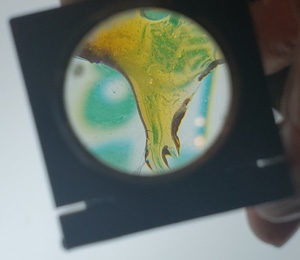
Weirdest and Most Difficult Things to Test
C4: Most difficult to analyze: Bath balms. “It took months of drilling down to find an acceptable RSD (relative standard deviation.)”
Weirdest: Mother’s milk (the patient was worried about DCS interference, though C4 declined because the product was a biohazard.)
Delta Verde Labs: “There is no end to the types of things people try to put THC or CBD into. But we try to test it all.”
Desert Valley Testing: most difficult product they’ve tested are transdermal patches. “The adhesive changes the results. We had to determine what chemicals were part of the glue and which ones were the active ingredients. That took some learning. We changed our methods ten times to perfect it,” Erin Polly explained. “But now we’ve got it perfect,” Erin Newcomb quickly added.
Weirdest product: “Hands down, CBD infused gerbil food.”
KB: Most difficult to test: topical cremes because of their chemistry. “Solvents, fragrances, other oils. You really have to dial down to get usable results.”
Weirdest product to test: Cannabis oil suppositories. Lerer laughs, “Did you know they come in various sizes?” Talia blushes.
Level One: Most difficult to analyze: Yep, it’s the bath balm, it’s got a low concentration in the first place and then there’s the challenge of separating out the fragrances.
Weirdest product: Beef Jerky. “It was worse than it sounds. It was just basically dried meat, in a bag, floating in some kind of black greasy cannabis sauce. No wonder that stuff didn’t catch on.”
Pure Labs: Most difficult to test are the salves and balms. Chief scientist Dwain Irvan explains, “though I will say we were ALL impressed at how difficult it is to get into some of these cartridges to get to the oil to test it.” They haven’t seen anything too weird.
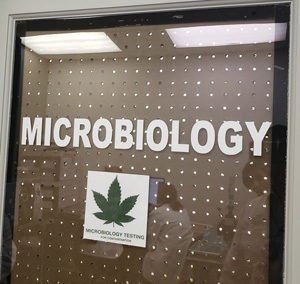
Glossary of Incomprehensible Abbreviations and/or Insider Jargon
ACLA—Arizona Cannabis Lab Association, professional trade association for AZ testing labs. Formed in late 2018 to be the driving force behind the passage of Sen David Gowan’s SB1494. Represented by Gowan’s former chief of staff, lobbyist Brett Mechem, ACLA negotiated every comma of the ever-evolving legislative package, including as many as 15 stakeholders at some meetings.
ADA—Arizona Dispensary Association, leading industry owners’ group, key player in legislative reforms. Represented by lobbyist Pele Fischer, the ADA helped negotiate between DHS interests and industry concerns in shaping SB1494.
Aliquot—Sample taken for scientific analysis. The single gram selected for testing from a grow is an aliquot. The smaller portions the sample is divided into for individualized tests are also aliquots.
AMMA—Arizona Medical Marijuana Law, 2010 voter initiative that created DHS MMJ program.
ARS36-2801—Section of state Law covering AMMA.
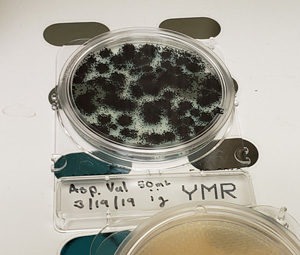
Aspergillosis—Deadly form of mold with four potentially lethal sub-strains, linked to patient injuries and deaths in multiple states and a condition known as Chronic Pulmonary Aspergillosis that comes from smoking contaminated cannabis.
AZDA–Arizona Department of Agriculture, as of June 1, 2019 AZDA regulates hemp and hemp products, which must be tested to prove they contain no more than .3% THC.
AZ-NORML—Arizona chapter of the National Organization of Marijuana Laws, key player in legislative reforms, spearheaded original testing efforts in 2017 which led to 2019’s SB1494.
CFU—Colony Forming Unit, bacterial population unit used to estimate the number of viable bacteria or fungal cells in a sample. In the real-world mold spores and microbes are nearly universal, on your clothes, in your kitchen and in your cannabis. The question is, is the microbe population large enough to spread and cause harm through their poisonous by-products, known as mycotoxins. Some types of microbial tests check for total microbial presences, others, using genetic markers like DNA, focus only on the most dangerous types, like Aspergillosis.
CLIA—Clinical Laboratory Improvement Amendments, governing US standards for all clinical labs that perform tests on humans.
Confident Cannabis—Founded in 2015, by Stanford Business School grads, Confident Cannabis works directly with 40% of America’s testing labs to organize and record test results from thousands of labs and dispensaries, creating the world’s largest database for cannabis test results.
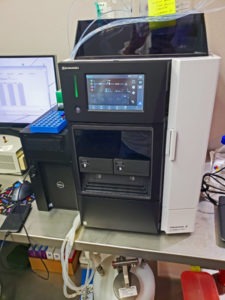
CSI—Cannabis Safety Institute, “composed of a large group of scientists and policy-makers who have come together to provide the scientific background needed to ensure that the Cannabis industry grows in a way that is safe and sustainable,” CSI publishes safety standards and recommended protocols in addition to white papers and scientific of cannabis and cannabis lab practices.
D2–Downtown Dispensary number two, one of two Tucson dispensaries owned by Mohit Asnani, an ADA board member who hired super lobbyist, Gibson McKay, to work on HB2149, a bill to solve the concentrates crisis filed before the Supreme Court accepted the Jones Case. McKay was critical to the final passage of SB1494.
DA Cards—Dispensary Agent Cards, like a patient MMJ card, all dispensary agents must have a card issued by DHS. Unlike patient cards, DA cards cost $500 and are not transferable. If an agent switches jobs the new dispensary has to get the employee a whole new $500 card. However, with a DA card a testing lab or individual lab tech came possess and process an unlimited amount of properly documented cannabis. Lab techs who only have a patient card can only possess 70 grams at a time.
DHS—Department of Health Services, DHS regulates the state medical marijuana program.
DNA—These natural building blocks of all organic life are used in testing for microbial contamination. Testers feed in the genetic background of leading microbial contaminants into a qPCR instrument, which can detect the presence of the exact DNA of microbes like e coli, aspergillus, and powdery mildew.
Dry Labbing—Corrupt practice of pretending to run lab tests while accepting bribes to report desired results. Often the untested samples are then sold into the black market.

DVT—Desert Valley Testing, oldest lab in state, commonly known by its initials.
e. Coli—Deadly fecal bacteria responsible for hundreds of cases of food poisoning each year. Also, occasionally present as a contaminant in cannabis cultivation, it’s one of the microbes that’s considered irremediable. A story on e coli contamination of Yuma lettuce inspired Talia Lerer to join her father in launching KB Labs.
FOCUS—Focus On Cannabis Unified Standards, PHX-based national cannabis group organization that helps draft state regulations for state cannabis programs around the country. Played a key role in 2019 legislative efforts, helping draft Dr Randy Friese’s HB2537. Some of those provisions would end up in the final version of SB1494.
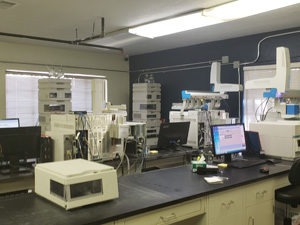
GCMS–Gas Chromatography Mass Spectrometry, widely used analytic instrument that combines aspects of gas-chromatography and mass spectrometry and can detect multiple individual chemicals in a single aliquot testing run.
Geno Grinder—Specialized ultra-Cuisinart-type grinding machine that can slice and dice aliquots in subcellular particles that ensures “tissue homogenization” for more thorough testing.
HB2149–Bill filed by Rep Tony Rivero (LD21-R) that would have redefined “cannabis” in state criminal statutes to protect concentrates in the AMMA. While that bill ultimately failed, the lobbyist working the bill, Gibson McKay stayed on board with the reform effort and helped pass SB1494.
Hemp—A cannabis sativa plant with less the .3% THC by dry weight. “Hot Hemp,” or hemp testing above .3% usually must be destroyed. Cannabis testing labs are expected to build a robust business of hemp testing now that AZ has an industrial hemp program.
HIA-Hemp Industry Association, national organization executive director Colleen Lanier is on AZ’s Industrial Hemp program rules committee.
HITA—Hemp Industry Trade Association, AZ’s hemp industry organization.
HIV—patients are particularly susceptible to microbial contaminants due to their compromised immune system. In the winter 2016-2017 5 northern California MMJ patients died from an outbreak of fungal pneumonia linked to moldy weed sold in the Bay Area.
HPLC–High-performance liquid chromatography, one of the more widely used testing methods, HPLC equipment is used in biochemical research, as well as pharmaceutical, forensic and environmental testing.
IAS—PHX-based general analytical testing lab, used by many cannabis labs for their heavy metals analysis (NOT Metallica-related)
IPM—Integrated Pest Management, pest control approach that involves using a variety of pest deterrents including beneficial microbes and insect species, plus physical and non-chemical pest suppressants such as glue strips.
ISO—The International Organization for Standardization, founded in 1947, this group establishes and certifies top quality practices in commerce, manufacturing and science. Recognized in 164 countries, ISO sets internationally accepted business and scientific standards in thousands of fields including–
ISO-17025—which is the code for scientific analytical labs, including cannabis labs. Qualifying for ISO-1725 certification is a two-year process.
KB—Kanna Bosm, the name of Boaz and Talia Lerer’s testing company comes from Old Testament references to cannabis in the Bible. Moses even uses hemp oil to anoint his meeting tent in Exodus 30:22- 23.
LCQQQ (aka LC Triple Quad)— liquid chromatography with triple-quadrupole mass spectrometry, or LC-QqQ MS, is also commonly referred to as Triple Quadrupole Mass Spectrometer (TQMS). Without getting beyond our own technical comprehension level, this instrument, developed in the 1970s, combines features of liquid chromatography with mass spectrometry and using three quadrupoles (defined as “a distribution of electric charge or magnetization consisting of four equal monopoles, or two equal dipoles, arranged close together with alternating polarity and operating as a unit). Sure.
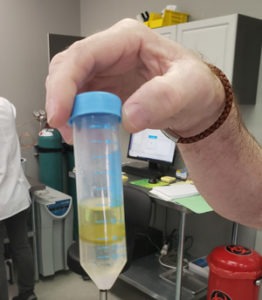
Lysate—Fully pulverized biological sample with even the individual cell walls dismantled. After being run through a Geno Grinder, the powdered cannabis is then ready to be dissolved for testing.
MITA-AZ—Marijuana Industry Trade Association of Arizona, industrywide cannabis professional trade association stepped up following the 2017 legislative session and took the lead in the 2018 SB1420 legislative effort. Represented by lobbyist Tory Roberg and working with House minority leader Dr Randy Friese, MITA proved to be a key player in expanding SB1494 to include additional non-testing related-provisions, such as the two year card costs.
Moisture Content—measures the curing of the cannabis flower sample. Ideally, finished cannabis is cured to within 10-12% moisture content, too low and the plant crumbles to dust, too high and it will roll and burn poorly and still be susceptible to fungal outbreaks.
MSO—Multi State Operator, corporate cannabis companies with cannabis operations in multiple states (Think Curaleaf, MedMen or Harvest). In the AZ testing battles, MSOs tended to be supportive of testing reforms since their companies are already being tested in other states.
Petri Dish/Petri-film—Standard method of testing for microbials goes back to the days of Alexander Fleming and simply smearing some of the sample across a grow medium in a petri dish or on the newly popularized 3M petri-film and waiting 48 hours to see if bacteria colonies sprout up. Lab techs literally count the clusters of bacteria growing in the dish to calculate the level of contamination.

Phytoremediation—The ability of cannabis plants to absorb toxins out of the soil, used in Italy to reclaim land at toxic waste sites. On the downside, the toxins are then locked in the plant material, which can lead to heavy metals contamination.
PM—Powdery Mildew, the scourge AZ’s hyper-humid indoor cultivation model. Can ruin an entire room of plants within a matter of days
PPM—Parts Per Million, standard scale of measurement for most contaminants
PPB—Parts Per Billion, a scale used for particularly dangerous contaminants like heavy metals.
PPT—Parts Per Trillion, by this point it may seem like you’re just being obnoxious, but heavy metal tests are sometimes processed in PPTs, though the equipment to analyze samples at this scale is very pricey.
PCR— Polymerase Chain Reaction, a method of determining a microbe’s DNA.
Prop105 Protected—After the state legislature torpedoed AZ’s successful 1996 marijuana citizens’ initiative, the following election, voters overwhelmingly passed Prop105, a citizens’ initiative that said the legislature could not longer overrule the intent of a citizens’ initiative without getting 3/4s vote in both the House and Senate. AMMA or 2010’s Prop203 is a Prop105 Protected program.
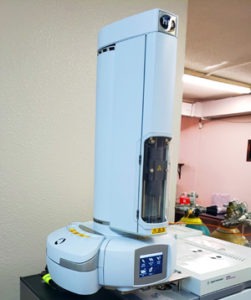
QAO–Quality Assurance Officer, checks, and double checks test results and operational protocols.
qPCR—Quantitative Polymerase Chain Reaction, like regular PCR, can identify microbes, but is designed to identify multiple types of microbes and the size of their colonies.
Quad—Nickname for an LCQQQ [SEE above].
‘Quot—nickname for aliquot [SEE above].
QTOF—A mass spectrometer with only one, instead of three, quadrupole analyzers.
R&D—Research and Development.
RT-PCR–Reverse Transcription Polymerase Chain Reaction, uses RNA instead of DNA to identify microbes.
SB1420—Failed 2018 testing bill that would have sent cannabis testing to AZDA, like the Industrial Hemp Program.
SB1494—Successful 2019 testing bill that kept cannabis regulation within AZ-DHS.
TQMS–Triple Quadrupole Mass Spectrometer, yep, it’s a fourth way to refer to a quad.
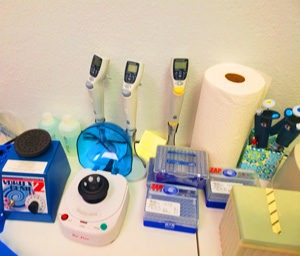
Water Activity—Similar to moisture content but dealing with the amount of loose or available water on or in the plant that can be used for microbial growth. For example, though lettuce has quite a bit of water inside its cellular makeup that water is bound within the plant. Water on the outside of the plant, however, can be a breeding ground for bacteria. With properly cured cannabis, passing a water activity test can indicate minimal microbial presence and thus safe marijuana. This technology was originally developed in the food safety field. Whereas a qPCR machine can cost upwards of three hundred thousand dollars, a water activity testing wand can be found for a few hundred dollars and used by growers throughout the grow cycle to protect plant susceptibility to microbial infestation.
White Label—Companies that repackage wholesale products with retail outlet labels. Numerous CBD companies buy bulk CBD for central supplier and apply their own branding
Stay Tuned for Part 3: The Pioneers (Desert Valley Testing & Delta Verde Labs)


